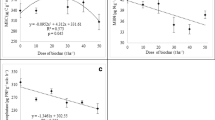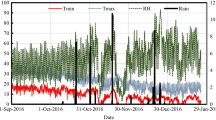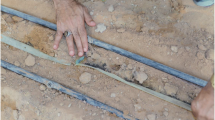Abstract
Nutrients are important for growth and development of plants and microbes, and they are also important factors in plant disease control. The objective of this study was to evaluate the effect of a rock dust used as a fertilizer in maintaining health of soil and tomato plants under greenhouse conditions. Four treatments—including M (commercial organic fertilizer), A (rock dust soil amendment), M + A (commercial organic fertilizer + rock dust soil amendment) and CK (blank control)—were examined for their effect on soil properties, soil enzymatic activity, plant growth and control efficacy against tomato bacterial wilt. Treatments A and M + A were significantly better than other treatments in changing soil pH, increasing it from acidic (pH 5.13) to nearly neutral (pH 6.81 and 6.70, respectively). Enzymatic activities in soil were notably influenced by the different treatments—particularly treatment M + A, which increased the activities of alkaline phosphatase, urease, catalase and sucrase to a greater extent in soil. There was no significant difference (P < 0.05) in the effects of treatments A and M + A on tomato plant height, stem diameter and biomass. The effect of the four treatments on the chlorophyll content and photosynthetic rate (in decreasing order) were M + A, A, M and CK. The replicate greenhouse experiments showed that the control efficacies of treatments M + A, A, and M against bacterial wilt were respectively 89.99, 81.11 and 8.89 % in first experiment and with the efficacies of 84.55, 74.36, and 13.49 % in the replicate; indicating that rock dust played a key role in the plant–soil interaction. The raised soil pH and Ca content were the key factors for the rock dust amendment controlling bacterial wilt under greenhouse conditions.


Similar content being viewed by others
References
Agrios NG (2005) Plant Pathology, 5th edn. Elsevier, Amsterdam, p 635
Anthony WDL, Michael K (2005) Chlorophyll d: the puzzle resolved. Trend Plant Sci 10:355–357
APHA (American Public Health Association), AWWA (American Water Works Association), WEF (Water Environmental Federation) (1998) Standard methods for the examination of water and wastewater, 20th edn. American Public Health Association, APHA, Washington, DC
Badawy SH, Helal MID, Chaudri AM, Lawlor K, McGrath SP (2002) Soil solid-phase controls lead activity in soil solution. J Environ Qual 31:162–167
Birkhofer K, Bezemer TM, Bloem J, Bonkowski M, Christensen S, Dubois D, Ekelund F, Fließbach A, Gunst L, Hedlund K, Mäder P, Mikola J, Robin C, Setäla H, Tatin-Froux F, Van der Putten WH, Scheu S (2008) Long-term organic farming fosters below and aboveground biota: implications for soil quality, biological control and productivity. Soil Biol Biochem 40:2297–2308
Bittman S, Forge TA, Kowalenko CG (2005) Response of the bacterial and fungal biomass in a grassland soil to multi-year applications of dairy manure slurry and fertilizer. Soil Biol Biochem 37:613–623
Bremner JM, Mulvaney CS (1982) Nitrogen-total. In: Page AL, Miller RH, Keeney DR (eds) Methods of soil analysis. Part 2. Chemical and microbiological properties. America Society of Agronomy, Madison, pp 595–641
Campbell RN, Greathead AS (1990) Control of clubroot of crucifers by liming. In: Engelhard AW (ed) Management of diseases with macro- and microelements. APS Press/American Phytopathological Society, St. Paul, pp 90–101
Dang MV (2005) Soil–plant nutrient balance of tea crops in the northern mountainous region, Vietnam. Agric Ecosyst Environ 105:413–418
Datnoff LE, Elmer W, Huber DM (eds) (2006) Mineral nutrition and plant disease. APS Press, St. Paul
Dible WT, Truog E, Berger KC (1954) Boron determination in soils and plants: simplified curcumin procedure. Anal Chem 26:418–421
Dordas C (2008) Role of nutrients in controlling plant diseases in sustainable agriculture: a review. Agron Sustain Dev 28:34–46
Du Laing G, De Vos R, Vandecasteele B, Lesage E, Tack FMG, Verloo MG (2008) Effect of salinity on heavy metal mobility and availability in intertidal sediments of the Scheldt estuary. Estuar Coast Shelf Sci 77:589–602
Earhart CF (1996) Uptake and metabolism of iron and molybdenum. In: Neidhardt FC, Curtiss R III, Ingraham JL, Lin ECC, Low KB, Magasanik B, Reznikoff WS, Riley M, Schaechter M, Umbarger HE (eds) Escherichia coli and Salmonella: cellular and molecular biology, vol 1, 2nd edn. ASM Press, Washington, DC, pp 1075–1090
Elad Y, David DR, Harel YM, Borenshtein M, Kalifa HB, Silber A, Graber ER (2010) Induction of systemic resistance in plants by biochar, a soil-applied carbon sequestering agent. Phytopathology 100:913–921
Fang ZD (1998) Methods in plant pathology, 3rd edn. Chinese Agricultural Press, Beijing
Fliessbach P, Oberholzer HR, Gunstm L, Mäderm P (2007) Soil organic matter and biological soil quality indicators after 21 years of organic and conventional farming. Agric Ecosyst Environ 118:273–284
Graham DR (1983) Effects of nutrients stress on susceptibility of plants to disease with particular reference to the trace elements. Adv Bot Res 10:221–276
Graham DR, Webb MJ (1991) Micronutrients and disease resistance and tolerance in plants. In: Mortvedt JJ, Cox FR, Shuman LM, Welch RM (eds) Micronutrients in agriculture, 2nd edn. Soil Science Society of America Inc., Madison, pp 329–370
Guan SY (1986) Soil enzyme and its research methods. China Agricultural Press, Beijing (In Chinese)
Guo DP, Guo YP, Zhao JP, Liu H, Peng Y, Wang QM, Chen JS, Rao GZ (2005) Photosynthetic rate and chlorophyll fluorescence in leaves of stem mustard (Brassica juncea var. tsatsai) after turnip mosaic virus infection. Plant Sci 168:57–63
Hayward AC (1991) Biology and epidemiology of bacterial wilt caused by Pseudomonas solanacearum. Annu Rev Phytopathol 29:65–87
Huber DM (1980) The role of mineral nutrition in defense. In: Horsfall JG, Cowling EB (eds) Plant disease, an advanced treatise, vol 5. How plants defend themselves. Academic, New York, pp 381–406
Huber DM, Graham RD (1999) The role of nutrition in crop resistance and tolerance to disease. In: Rengel Z (ed) Mineral nutrition of crops fundamental mechanisms and implications. Food Product Press, New York, pp 205–226
Huber DM, Haneklaus S (2007) Managing nutrition to control plant disease. Landbauforsch Volk 57:313–322
Jackson ML (1967) Soil chemical analysis. Prentice Hall Inc., Englewood Cliffs
Jones JP, Engelhard AW, Woltz SS (1989) Management of fusarium wilt of vegetables and ornamentals by macro and microelement nutrition (p 18–32). In: Engelhard AW (ed) Soilborne plant pathogens: management of diseases with macro- and microelements. American Phytopathological Society, p 217
Kim BJ, Park JH, Park TH, Bronestin PA, Schneider DJ, Cartinhour SW, Shuler ML (2009) Effect of iron concentration on the growth rate of Pseudomonas syringae and the expression of virulence factors in hrp-inducing minimal medium. Appl Environ Microb 75:2720–2726
Ko WH, Kao CW (1989) Evidence for the role of calcium in reducing root diseases incited by Pythium species. In: Engelhard AW (ed) Soilborne plant pathogens: management of diseases with macro and microelements. American Phytopathological Society, St. Paul, MN, pp 205–217
Li JG, Jiang ZQ, Xu LP, Sun FF, Guo JH (2008) Characterization of chitinase secreted by Bacillus cereus strain CH2 and evaluation of its efficacy against verticillium wilt of eggplant. Biocontrol 53:931–944
Li JG, Liu HX, Cao J, Chen LF, Gu C, Allen C, Guo JH (2010) PopW of Ralstonia solanacearum, a new two-domain harpin targeting the plant cell wall. Mol Plant Pathol 11:371–381
Linus-Muriithi MM, Irungu JW (2004) Effect of integrated use of inorganic fertilizer and organic manures on bacterial wilt incidence (BWI) and tuber yield in potato production systems on hill slopes of central Kenya. J Mt Sci 1:81–88
Mäder P, Fliessbach A, Dubois D, Gunst L, Fried P, Niggli U (2002) Soil fertility and biodiversity in organic farming. Science 296:1694–1697
Marschner H (1995) Mineral nutrition of higher plants, 2nd edn. Academic, London, p 889
Minuto A, Spadaro D, Garibaldi A, Gullino ML (2006) Control of soilborne pathogens of tomato using a commercial formulation of Streptomyces griseoviridis and solarization. Crop Prot 25:468–475
Muchovej VV, Muchovej RCM, Dingra OD, Maffia LA (1980) Suppression of anthracnose of soya beans by calcium. Plant Dis 64:1088–1089
Nelson KL, Boiteau G, Lynch DH, Peters RD, Fillmore S (2010) Influence of agricultural soils on the growth and reproduction of the bio-indicator Folsomia candida. Pedobi 54:79–86
Olsen SR, Cole CV, Watanabe FS, Dean LA (1954) Estimation of available phosphorus in soils by extraction with sodium bicarbonate. Circular No. 939. US Department of Agriculture, Washington, DC
Omar I, O’Neill TM, Rossall S (2006) Biological control of Fusarium crown and root rot of tomato with antagonistic bacteria and integrated control when combined with the fungicide carbendazim. Plant Pathol 55:92–99
Parr JF, Papendick RI (1983) Strategies for improving soil productivity in developing countries with organic wastes. In: Lockertz W (ed) Environmentally sound agriculture. Praeger Scientific, New York, pp 131–141
Pimentel D (2005) Environmental and economic costs of the application of pesticides primarily in the United States. Environ Develop Sustain 7:229–252
Porra RJ, Thompson WA, Kriedemann PE (1989) Determination of accurate extinction coefficients and simultaneous equations for assaying chlorophylls a and b extracted with four different solvents: verification of the concentration of chlorophyll standards by atomic absorption spectroscopy. Biochim Biophys Acta 975:384–394
Roberts DP, Denny TP, Scbell MA (1988) Cloning of the egl gene of Pseudomonas solanacearum and analysis of its role in phytopathogenicity. J Bacteriol 170:1445–1451
Skujins JJ, Braal L, McLaren AD (1962) Characterization of phosphatase in a terrestrial soil sterilized with an electron beam. Enzymologia 25:125–133
Slininger PJ, VanCauwenberge JE, Shea-Wilbur MA, Bothast RJ (1998) Impact of liquid culture physiology, environment, and metabolites on biocontrol agent qualities, Pseudomonas fluorescens 2–79 versus Take-All. In: Boland GJ, Kuykendall LD (eds) Plant-microbe interactions and biological control. Marcel Dekker, Inc., New York, pp 329–353
Stockdale EA, Lampkin NH, Hovi M, Keatinge R, Lennartsson EKM, Macdonald DW, Padel S, Tattersall FH, Wolfe MS, Watson CA (2000) Agronomic and environmental implications of organic farming systems. Adv Agron 70:261–327
Subbiah BV, Asija GL (1956) A rapid procedure for estimation of available nitrogen in soils. Curr Sci 25:259–260
Sullivan P (2004) Sustainable management of soil-borne plant diseases. http://www.attra.org/attra-pub/PDF/soilborne.pdf
van Eekeren N, de Boer H, Bloem J, Schouten T, Rutgers M, de Goede R, Brussaard L (2009) Soil biological quality of grassland fertilized with adjusted cattle manure slurries in comparison with organic and inorganic fertilizers. Bio Fertil Soils 45:595–608
Wang AS, Angle JS, Chaney RL, Delorme TA, Reeves RD (2006) Soil pH effects on uptake of Cd and Zn by Thlaspi caerulescens. Plant Soil 281:325–337
Weller M, Thomashow LS, Cookm RJ (1995) Biological control of soil-borne pathogens of wheat: benefits, risks and current challenges. In: Hokkanen HMT, Lynch JM (eds) Biological control: benefits and risks. Cambridge University Press, Cambridge, pp 149–160
Yabuuchi E, Kosako Y, Yano I, Hotta H, Nishiuchi Y (1995) Transfer of two Burkholderia and an Alcaligenes species to Ralstonia gen. Nov.: proposal for Ralstonia pickettii, Ralstonia solanacearum and Ralstonia eutropha. Microbiol Immunol 39:897–904
Zhang SS, Raza W, Yang XM, Hu J, Huang QW, Xu YC, Liu XH, Ran W, Shen QR (2008) Control of fusarium wilt disease of cucumber plants with the application of a bio-organic fertilizer. Biol Fertil Soil 44:1073–1080
Acknowledgments
This research was supported by innovation key program of the Chinese academy of sciences (KZCX2-YW-JC405), agricultural science and technology achievements transformation fund programs (2009GB24910540), and special fund for agro-scientific research in the public interest (200903011).
Author information
Authors and Affiliations
Corresponding author
Electronic supplementary material
Below is the link to the electronic supplementary material.
Rights and permissions
About this article
Cite this article
Li, JG., Dong, YH. Effect of a rock dust amendment on disease severity of tomato bacterial wilt. Antonie van Leeuwenhoek 103, 11–22 (2013). https://doi.org/10.1007/s10482-012-9781-4
Received:
Accepted:
Published:
Issue Date:
DOI: https://doi.org/10.1007/s10482-012-9781-4




